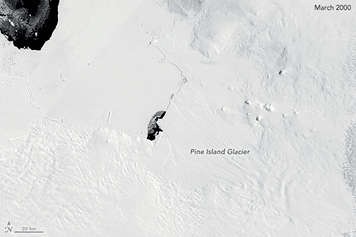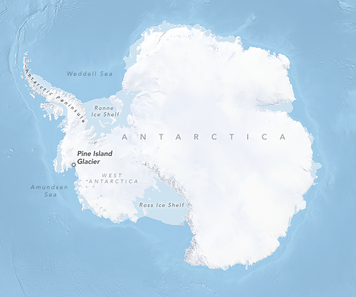Snow cannons can stabilize melting Antarctic ice shelves, physicists say

West Antarctica is an ominous place.
In this exceptionally remote region, ice is breaking off into the sea faster than it's naturally replenished by snowfall. Massive icebergs — recently one five times the size of Manhattan — have broken off into the ocean more frequently since 2001. This is bad. As West Antartica's ice shelves — the ends of great glaciers that float over the ocean — continue snapping off, eventually they'll lose the critical point at which they're grounded to the ocean floor, resulting in their collapse. Critically, these grounded ice shelves act like plugs, holding back West Antarctic ice sheets from flowing unhindered into the ocean. This could trigger some 3 meters of sea level rise.
To potentially thwart this future, should an irreversible West Antarctic horror come to pass, environmental physicists at the Potsdam Institute for Climate Impact Research released research Wednesday suggesting a grandiose geoengineering project. They assessed the strategy of pumping in trillions of tons of ocean water and then using snow cannons to blow massive amounts of artificial snow over the ice shelves. This would, they argue, stabilize the ice and halt the retreat. Yes, it's an intentionally far-fetched idea, and illustrates the profound difficulty of solving such a challenging environmental problem.
"It shows how huge the problem is," said Anders Levermann, an author of the study and head of the Complexity Science research department at the Potsdam Institute for Climate Impact Research.
"We are not necessarily proposing it, but it's an option," Levermann added.

Image: NASA EOSDIS / LANCE and GIBS / Worldview
The ambitious engineering scheme involves installing around 90 industrial pumping stations to suck water out of the ocean and push that water inland, through freeze-resistant pipes. Using the water, the physicists found that if giant snow cannons created a whopping 7.4 trillion metric tons, or 7,400 gigatonnes, of snowfall, the West Antarctic ice sheets would become stabilized.
The basic principle is adding ice (by way of falling artificial snow) to the surface to counteract what's eating away at the ice shelves from below: influxes of relatively warmer ocean waters thinning the undersides of the ice. "We computed it and it works," said Levermann.
Polar scientists are still investigating what's driving these warm water influxes and resulting instability in West Antarctica. The culprit very well could be climate change, as warmer waters thin the ice from below, eventually leading to the collapse of ice shelves. "This area of central West Antarctica has been thought to be prone to this kind of collapse, and some (controversial) evidence of its past loss during past warm periods supports the idea that it [ice] could quickly unload from the ice sheet in the warming climate and ocean anticipated for the end of this century and beyond (perhaps sooner, to start)," Ted Scambos, a senior research scientist at the University of Colorado who had no role in the study, said over email.
The time lapse between begin Oct 2000 and end Mar 2019 highlights the disintegration of the @ThwaitesGlacier Tongue even more. pic.twitter.com/na1Lv6FMEv
— Stef Lhermitte (@StefLhermitte) March 6, 2019
The challenges of such a geoengineering project are tremendous.
Making that much ice would require pumping some 7.4 trillion tons of water from the ocean. "Or, an Olympic pool for every human being on Earth," noted Scambos.
"Moreover, the water for these pools would need to be pumped hundreds of kilometers inland and over 2000 [feet] uphill," he added.
SEE ALSO: June was the warmest June ever recorded, but there's a bigger problem
This would require a massive amount of energy, something on the order of "several ten thousand high-end wind turbines," the authors concludes.
Acknowledging the near-impossibility of such an endeavor, it would almost certainly be much easier to slash the amount of heat-trapping carbon emissions being emitted in the atmosphere today — now at rates that are unprecedented in both the geological and historical record. "I think overall the value of the study is to strengthen the case of simply addressing decarbonization — and it would appear that [the authors] understand this and wanted to discuss the challenge in a frank and objective way," Scambos said.

Image: NASA
But, should West Antarctica follow current trends and continue to destabilize, such a grand geoengineering plan may one day look more appetizing. Three meters of sea level rise will imperil not just hundreds of millions of coastal dwellers, but vast swathes of vital economic powerhouses, and their invaluable cultural heritages.
"What is the value of New York City?" asked Levermann. "What is the value of Hong Kong?"
The almost incalculable price estimates for such a geoengineering undertaking are beyond the realm of this study, Levermann noted. But it would mean spending less money on massive coastal walls and fortifications, he noted. And it would also likely act as a subsidy to national economies as countries put contractors and engineers to work, similar to NASA's Apollo program, the New Deal, or U.S. defense spending.
"It's not for scientists to decide whether to do it or not," said Levermann. "It's for society to decide."
WATCH: Ever wonder how the universe might end?


